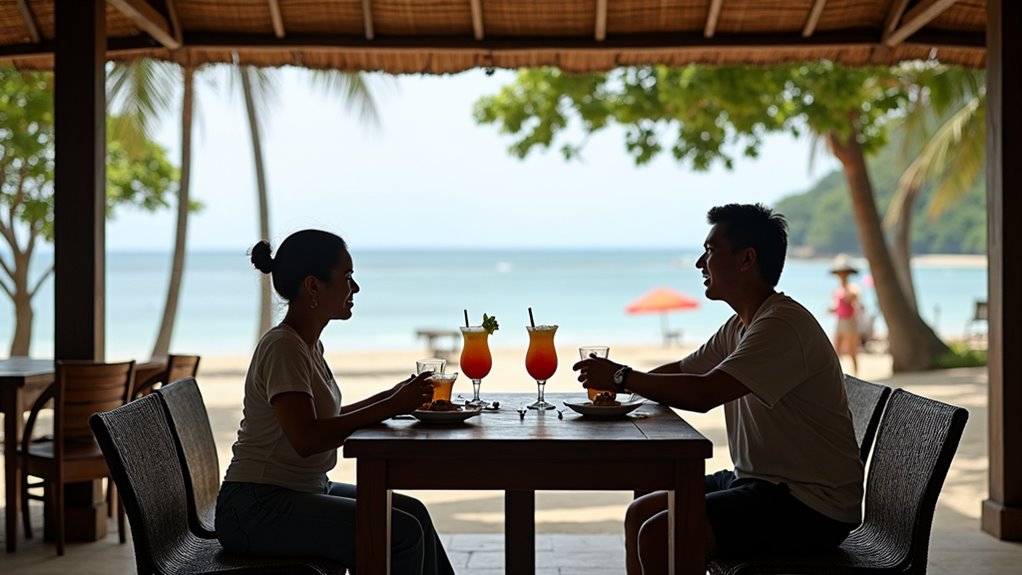Physical Address
304 North Cardinal St.
Dorchester Center, MA 02124
Physical Address
304 North Cardinal St.
Dorchester Center, MA 02124

Glimmering Bali beckons travelers worldwide, but does this island paradise demand your life savings or welcome budget adventurers too?
Like the fabled land of Lotus-eaters where visitors never want to leave, Bali captures hearts while potentially draining wallets—if you’re not careful. You’ve probably wondered if this Indonesian paradise fits your budget or requires financial sacrifice. The answer isn’t straightforward—Bali can be as affordable or luxurious as you make it. Whether you’re planning to stretch your dollars for months or splurge on a week of indulgence, understanding the real costs will determine if this island paradise is your financial paradise too.

While many tropical paradises come with hefty price tags, Bali is notable as an exception that won’t drain your savings. The island offers numerous ways to keep your expenses low without sacrificing the quality of your experience.
Discover Bali: where paradise meets affordability, allowing travelers to experience tropical luxury on any budget.
You’ll find affordable transportation options ranging from cheap scooter rentals to public bemos and ride-hailing apps. Bikago Scooter Rental provides affordable scooter rentals for exploring the island at your own pace.
Many of Bali’s stunning attractions are completely free, including beautiful beaches and traditional villages.
When you’re hungry, local warungs serve delicious meals at a fraction of what you’d pay at home. Bali offers average travel costs that are significantly lower than other tropical destinations.
Budget-friendly activities abound, from the Sacred Monkey Forest to the Tegalalang Rice Terrace, both with modest entrance fees.
Even organized tours to iconic spots like Tanah Lot Temple or snorkeling excursions can be booked at reasonable rates.
When searching for a place to stay in Bali, you’ll discover a remarkably diverse range of accommodations that can fit virtually any budget.
Hostels offer the most economical option with dorm beds from $5-15 per night, with modern capsule-style pods under $15 at places like Stellar Capsules.
Budget hotels provide private rooms at $20-50, many including pools and beach proximity like EDEN Hotel Kuta.
For culture, family-run homestays in Sidemen or North Bali cost under $25 and typically include breakfast.
If you’re after affordable luxury, private pool villas can be found for $40-80 in emerging areas like Jatiluwih.
Boutique properties offer unique experiences through themed stays and hybrid models, often competing with mid-tier hotels through smart design rather than high prices.
Many highly-rated hotels like Kampi Hotel Legian earn perfect reviews while remaining budget-friendly for travelers seeking quality accommodations.
If you’re considering exploring beyond Bali, nearby Lombok offers similar accommodations but with generally lower prices and fewer travelers than its popular neighbor.

Food stands as another critical aspect of any Bali trip budget, with options spanning from $1 street food to $25+ fine dining experiences. Your location significantly impacts what you’ll pay—Seminyak and Nusa Dua command premium prices, while local markets offer substantial savings.
Street food vendors provide meals for $1-$3, casual restaurants range from $5-$10, and mid-range establishments cost $10-$25 per person. Most highly-rated restaurants like Kaukau and Padi fall into the moderate pricing category, indicated as $$ – $$$ on review sites. For an authentic experience, try sampling local Balinese cuisine which features unique flavors and ingredients specific to the island.
Be aware that alcohol dramatically increases your bill, potentially adding $20-$30 to your meal costs.
To maximize your dining budget, consider mixing high-end experiences with local warungs, take advantage of happy hours, and opt for fresh coconuts or juices instead of cocktails.
Shopping at local markets for ingredients is another smart strategy if you’re staying somewhere with cooking facilities.
Transportation in Bali offers options for every budget, from cheap public buses at $0.25 per trip to premium car rentals with drivers for $20-$60 per day.
For maximum savings, download Grab or Go-Jek for scooter taxis at just $1-$3 per trip—significantly cheaper than non-app options.
Renting your own wheels gives you freedom while saving money. Daily bicycle rentals cost $2-$4, while standard scooters run $5-$7.
When taking taxis, choose metered options starting at $0.50 plus $0.45/km.
Traffic affects costs, especially during peak hours, so plan routes in advance.
Public buses (Trans Sarbagita) are extremely affordable but have limited coverage outside Denpasar.
For airport transfers, check if your accommodation offers complimentary service before booking separately.
Premium scooters with insurance and enhanced safety features are available for premium prices of $10-$25 per day.
If you’re planning to explore Bali’s adventure activities, renting a scooter provides the most flexible and cost-effective way to reach remote beaches and mountain trails.

How much you’ll spend on Bali’s attractions largely depends on your adventure style. Most experiences fall between $10-$50, but budget options start as low as $2 for temple entries like Uluwatu.
Mid-tier activities such as parks and cultural sites typically cost $3-$15, while premium experiences like scuba diving start at $30+.
You’ll find plenty of free options too—cultural shows, beach access, and local markets require minimal spending.
Popular paid attractions include Sacred Monkey Forest ($3), Tirta Empul Temple (~$5), and Tegalalang Rice Terraces ($2-$10).
To maximize your budget, look for combo tour packages, book tickets online in advance, and prioritize street food to save for activities. For a relaxing evening experience, many visitors enjoy beach bars while watching Bali’s famous sunset views.
Your total daily budget for activities generally ranges from $20-$30 per person depending on what you choose.
Group discounts are often available for parties of four or more travelers.
While Bali remains relatively affordable year-round, prices fluctuate considerably based on when you visit. High season (July-August and December-January) brings 30-50% price hikes on accommodations, with beachfront properties often doubling their rates.
You’ll find the best deals during the rainy season (November-March, excluding holidays), when hotel prices drop by 20-40% and you’ll encounter fewer travelers. October and April offer excellent value as transitional months with good weather and lower prices.
Major Indonesian holidays like Nyepi and Galungan can affect pricing and availability, so plan accordingly. If you’re flexible with your travel dates, you can save hundreds on the same itinerary simply by shifting your visit by a few weeks to avoid peak pricing periods. Flying during the low season months of January to March and November can also significantly reduce your airfare costs. During off-peak times, you’ll also find better rates on bike rentals which are a popular and economical way to explore the island.

Understanding the stark contrast between vacation and long-term living expenses in Bali can markedly impact your budget planning. While vacationers might spend $100+ daily, long-term residents can comfortably live on $1,000-$2,000 monthly.
The key differences? Accommodation costs drop considerably with long-term leases—expect to pay $500 monthly versus nightly hotel rates. You’ll save on food by cooking at home and eating at local warungs instead of tourist restaurants. Transportation becomes cheaper too when you rent a scooter monthly ($50) rather than daily.
Living like a local in less touristy areas like Amed or Bedugul further reduces expenses. For a balanced experience between local living and tourist amenities, Sanur beach town offers a relaxed atmosphere with lower costs than popular areas like Seminyak. Consider negotiating long-term rentals, adopting local customs, and managing utilities carefully. These strategies can transform an expensive vacation destination into an affordable place to live. Proper visa research is essential for longer stays, with options like KITAS for retirees or B211 for extended tourism.
Bali won’t break the bank if you plan wisely. From $50 daily budgets to luxury splurges, this island paradise offers something for every wallet size. You’ll find the sweet spot by balancing affordable warungs with occasional nicer meals, mixing free beaches with paid attractions, and visiting during shoulder seasons. Like finding a pearl in an oyster, discovering Bali’s value requires just a little digging beneath the surface.